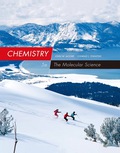
Concept explainers
(a)
Interpretation:
The mass of the glycol that have been added has to be determined.
Concept introduction
Freezing point is the temperature at which liquid turns into solid.
The Freezing point depression
Where,
(a)
Answer to Problem 77QRT
The mass of the glycol that have been added is
Explanation of Solution
Using Freezing point of the solution:
Given data is as follows:
Using the formula as shown below,
Mass of the glycol:
Therefore, the mass of the glycol that have been added is
(b)
Interpretation:
The boiling point of the coolant mixture has to be calculated.
Concept introduction
Boiling point is the temperature at which liquid turns into a gas. Example: boiling point of water is
Where,
The Boiling point elevation
Where,
(b)
Answer to Problem 77QRT
Boiling point of the solution is
Explanation of Solution
Given data as follows: Mass of ethylene glycol from part (a)
Mass of water is
Value of
Calculate mole of solute (urea):
Substituting the values of ethylene glycol mass and its molecular mass into the moles–mass conversion formula, the moles of the substance was obtained.
Calculate molality of the solution:
Substituting in the value of moles of the solute and mass of solvent in kilogram; molality of the solution was obtained.
Calculate Boiling point of the solution:
Using the boiling point formula as follows,
Substituting the values of molality, the boiling point was calculated.
Therefore, the Boiling point of the solution is
Want to see more full solutions like this?
Chapter 13 Solutions
EBK CHEMISTRY: THE MOLECULAR SCIENCE
- 6-111 As noted in Section 6-8C, the amount of external pressure that must be applied to a more concentrated solution to stop the passage of solvent molecules across a semipermeable membrane is known as the osmotic pressure The osmotic pressure obeys a law similar in form to the ideal gas law (discussed in Section 5-4), where Substituting for pressure and solving for osmotic pressures gives the following equation: RT MRT, where M is the concentration or molarity of the solution. (a) Determine the osmotic pressure at 25°C of a 0.0020 M sucrose (C12H22O11) solution. (b) Seawater contains 3.4 g of salts for every liter of solution. Assuming the solute consists entirely of NaCl (and complete dissociation of the NaCI salt), calculate the osmotic pressure of seawater at 25°C. (c) The average osmotic pressure of blood is 7.7 atm at 25°C. What concentration of glucose (C6H12O6) will be isotonic with blood? (d) Lysozyme is an enzyme that breaks bacterial cell walls. A solution containing 0.150 g of this enzyme in 210. mL of solution has an osmotic pressure of 0.953 torr at 25°C. What is the molar mass of lysozyme? (e) The osmotic pressure of an aqueous solution of a certain protein was measured in order to determine the protein's molar mass. The solution contained 3.50 mg of protein dissolved in sufficient water to form 5.00 mL of solution. The osmotic pressure of the solution at 25°C was found to be 1.54 torr. Calculate the molar mass of the protein.arrow_forwardCalcium chloride, CaCl2, has been used to melt ice from roadways. Given that the saturated solution is 32% CaCl2 by mass, estimate the freezing point.arrow_forwardThe dispersed phase of a certain colloidal dispersion consists of spheres of diameter 1.0 102 nm. (a) What are the volume (V=43r2) and surface area (A = r2) of each sphere? (b) How many spheres are required to give a total volume of 1.0 cm3? What is the total surface area of these spheres in square meters?arrow_forward
 Chemistry: The Molecular ScienceChemistryISBN:9781285199047Author:John W. Moore, Conrad L. StanitskiPublisher:Cengage Learning
Chemistry: The Molecular ScienceChemistryISBN:9781285199047Author:John W. Moore, Conrad L. StanitskiPublisher:Cengage Learning Chemistry & Chemical ReactivityChemistryISBN:9781133949640Author:John C. Kotz, Paul M. Treichel, John Townsend, David TreichelPublisher:Cengage Learning
Chemistry & Chemical ReactivityChemistryISBN:9781133949640Author:John C. Kotz, Paul M. Treichel, John Townsend, David TreichelPublisher:Cengage Learning Chemistry & Chemical ReactivityChemistryISBN:9781337399074Author:John C. Kotz, Paul M. Treichel, John Townsend, David TreichelPublisher:Cengage Learning
Chemistry & Chemical ReactivityChemistryISBN:9781337399074Author:John C. Kotz, Paul M. Treichel, John Townsend, David TreichelPublisher:Cengage Learning Chemistry: Principles and PracticeChemistryISBN:9780534420123Author:Daniel L. Reger, Scott R. Goode, David W. Ball, Edward MercerPublisher:Cengage Learning
Chemistry: Principles and PracticeChemistryISBN:9780534420123Author:Daniel L. Reger, Scott R. Goode, David W. Ball, Edward MercerPublisher:Cengage Learning General Chemistry - Standalone book (MindTap Cour...ChemistryISBN:9781305580343Author:Steven D. Gammon, Ebbing, Darrell Ebbing, Steven D., Darrell; Gammon, Darrell Ebbing; Steven D. Gammon, Darrell D.; Gammon, Ebbing; Steven D. Gammon; DarrellPublisher:Cengage Learning
General Chemistry - Standalone book (MindTap Cour...ChemistryISBN:9781305580343Author:Steven D. Gammon, Ebbing, Darrell Ebbing, Steven D., Darrell; Gammon, Darrell Ebbing; Steven D. Gammon, Darrell D.; Gammon, Ebbing; Steven D. Gammon; DarrellPublisher:Cengage Learning Chemistry: Principles and ReactionsChemistryISBN:9781305079373Author:William L. Masterton, Cecile N. HurleyPublisher:Cengage Learning
Chemistry: Principles and ReactionsChemistryISBN:9781305079373Author:William L. Masterton, Cecile N. HurleyPublisher:Cengage Learning





